Day 1 of two days of Private Tours today. It was mostly cloudy, with some brighter intervals, at least until late in the day when it cleared to blue sky and low sunshine. Another very pleasant day to be out, particularly after all the snow last week.
With lots of gulls reported along the NE coast yesterday, we decided to head over to Sheringham first thing. The storms last week washed up large quantities of sealife onto the beaches – fish, starfish, urchins, etc – and the gulls have been gathering in their hundreds to feed on the bounty, bringing a few of their scarcer cousins with them. We particularly hoped to catch up with one of the two Iceland Gulls here this morning.
As we walked down to the prom, we could immediately see lots of gulls on the sea just offshore. The tide was in, but rather than feeding on the fish washed up on the beach, the birds were busy picking food from the surface. We looked through them as we made our way east along the front – plenty of Black-headed, Common, Herring and Great Black-backed Gulls. A Rock Pipit flew in and landed on the concrete below us.
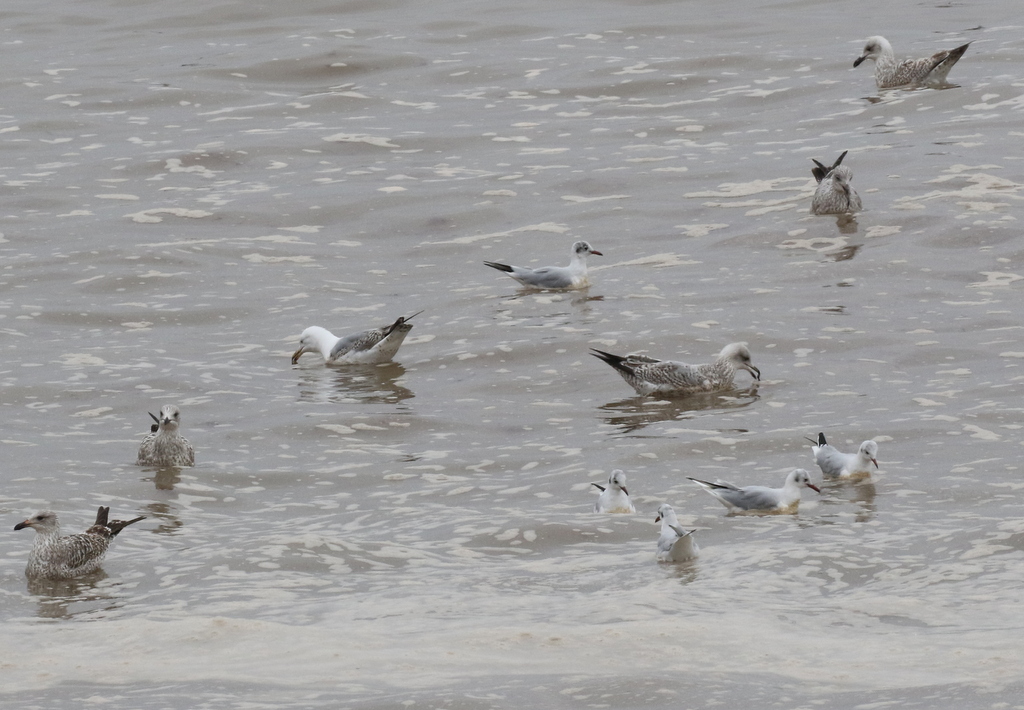
A quick stop to scan the rocky sea defenses, just below the prom, revealed a Purple Sandpiper with all the Turnstones. It was just below the top of some steps, so we walked over for a closer look. Two more Purple Sandpipers were roosting here too, partly hidden on the back edge of one of the large blocks. We had a great view of the three of them here – smart birds, with their yellow-orange legs and bill base, more subtle shades of grey than really purple!

The other two Purple Sandpipers did wake up when a large wave crashed in beneath them, but quickly went back to sleep. The original bird continued feeding, clambering around the faces of the blocks. It then flew down to a small shingle beach where it started to pick around in the detritus washed up here, finding a worm to its liking, before flying back up onto the blocks again.
Continuing on east to the end of the prom, we couldn’t find any other gulls of note among the throng – there was no sign of the Iceland Gull which had been here yesterday. We did spot a couple of Fulmars and a distant Red-throated Diver flying past offshore. We decided to head back and try our luck further along the coast, but at that point we had a message to way that there was no sign of any of yesterday’s gulls at Cromer either.
A change of plan was in order, so we turned round and headed west. Our next stop was at Salthouse. As we got out of the car on Beach Road, a scan of the wet grazing marshes revealed several Wigeon and Teal hiding in the pools and three Ringed Plovers out on the mud. Walking out towards Gramborough Hill, several Meadow Pipits flew up from the grass calling. A Linnet landed on the fence in front of us. Three Dunlin were feeding on the pool beside the path, along with two more Ringed Plovers and a Redshank.
Another pipit flew up from the back of the pool, with shriller call and not repeated like the Meadow Pipits. It was a Rock Pipit. It landed on the shingle at the back of the pool and we could get a closer look at it. When it turned in the light, it was possible to make out a pinkish-apricot wash behind the streaks on the breast. The Rock Pipits here are winter visitors from Scandinavia, of the race littoralis, and they can get very pink below in spring, leading to much potential confusion with Water Pipit.
As we rounded Gramborough Hill, we could see several small birds picking around the grassy patches on the remains of the shingle ridge just beyond. These were the Snow Buntings we had come here to see. They are very well camouflaged against the stones, but watching carefully, we could see that there were actually at least 30 of them here.
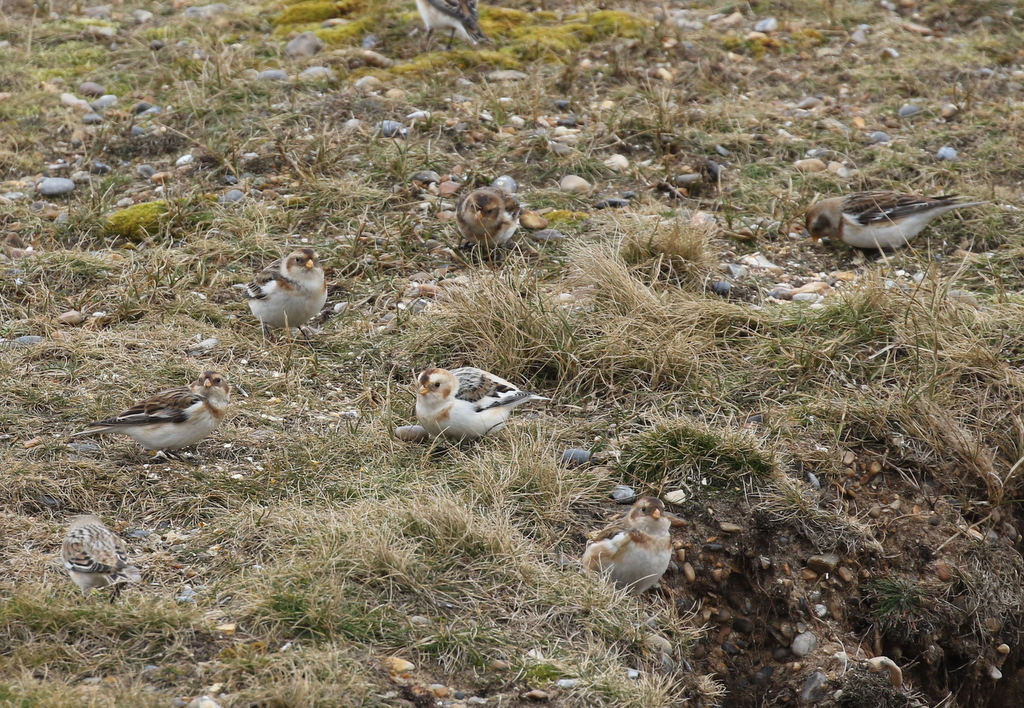
With a bit of care and patience, we managed to slowly edge ourselves into a position just below the grass where the Snow Buntings were feeding. They came down the ridge back towards us, giving us great close views. We could see they were a mixture of darker brown birds and paler white/grey/orange ones, the former from Iceland and the latter Scandinavian birds.
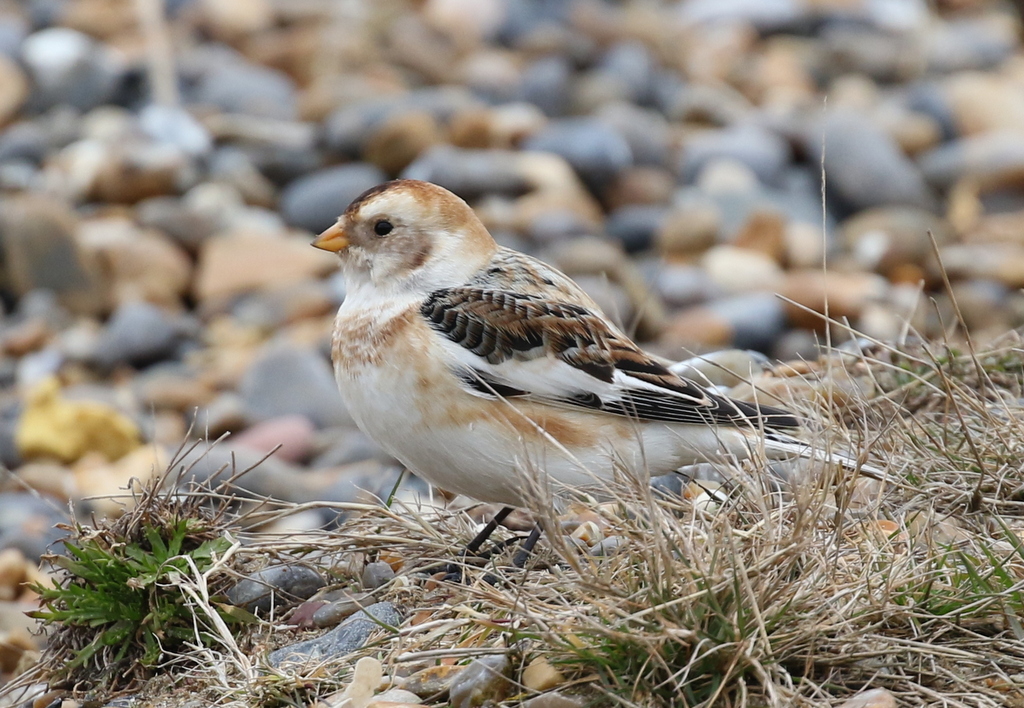
After enjoying the Snow Buntings for a while, we backed away carefully and left them to feed in peace. We planned to head for Holkham next, but on the way was drove round via the beach road at Cley. There were just a handful of Brent Geese here today, on Cricket Marsh, and nothing in the Eye Field. No sign of the main flock, which was probably feeding further inland.
We turned inland and headed up towards Wighton. A quick stop on the way produced a Great Spotted Woodpecker drumming in the trees. There had been a Great Grey Shrike seen just west of Wighton a week ago, before the snow, so we thought we might have a quick look in passing to see if it was still in the area. Perhaps not surprisingly, there was no sign of it – in previous years, it has appeared to roam over a vast area.
We had stopped by a small farm reservoir. There were lots of Greylag Geese and Shelducks around the top of the bank, a few small gulls were flying in to bathe and a couple of Tufted Ducks appeared, diving out on the water. Then we noticed another duck right in the far corner. It was face on to us and fast asleep with its head tucked in. Like this, it could easily have been overlooked as another Tufted Duck, but we just caught a flash of what looked like grey on its shoulder. Reaching for the scope, we could confirm it was actually a Scaup.

There have been a few Scaup seen along the coast in the last few days, so this one had possibly sought shelter from the weather on this small reservoir. It bobbed along the back edge of the water and turned sideways so we could see its grey back properly, very different from the black back of the Tufted Ducks. It appeared to be a young drake, still with some darker brown feathers in the flanks and mantle.
Dropping down to the coast at Holkham, there were various ducks and geese out on the marshes as we made our way up Lady Anne’s Drive. A pair of Egyptian Geese were out in the field just inside the gate. Further up, several Teal and Shoveler were feeding on the pools. A big flock of Wigeon was out in the grass at the north end, in front of where we parked.
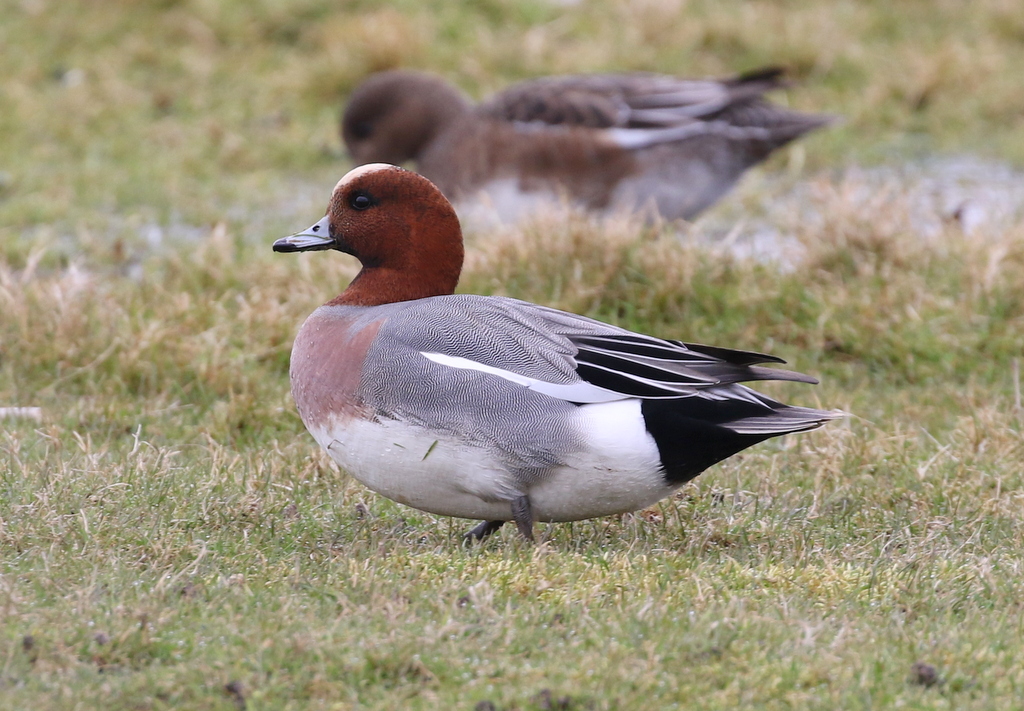
It was time for lunch, so we made good use of the picnic tables here. While we were eating, we heard a call high above and looked up to see a Marsh Harrier displaying way up the sky. We watched as it tumbled and twisted, calling periodically. There were lots of other raptors here too. A Common Buzzard was also displaying over the edge of the pines and a Red Kite drifted in over the trees and across the grazing marshes. At one point, they were all in the air circling together!
A lone Pink-footed Goose was sitting down in the grass not far from the path, which meant that we could get a really close look at it. When it got up and started feeding, we could see it was not holding its left wing properly. Possibly it had been shot and injured, and had now recovered sufficiently to get around but unable to join the rest of the flocks on their way back to Iceland.
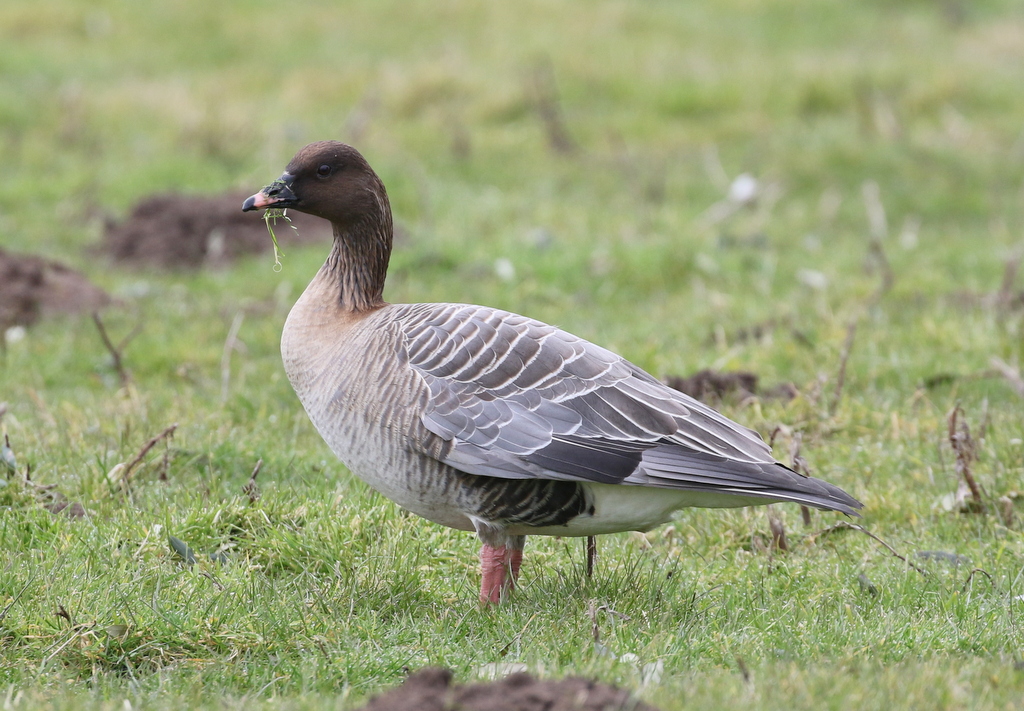
A single Brent Goose the other side of Lady Anne’s Drive was similarly very tame, but showed no sign of any obvious injuries to explain why it was on its own here.
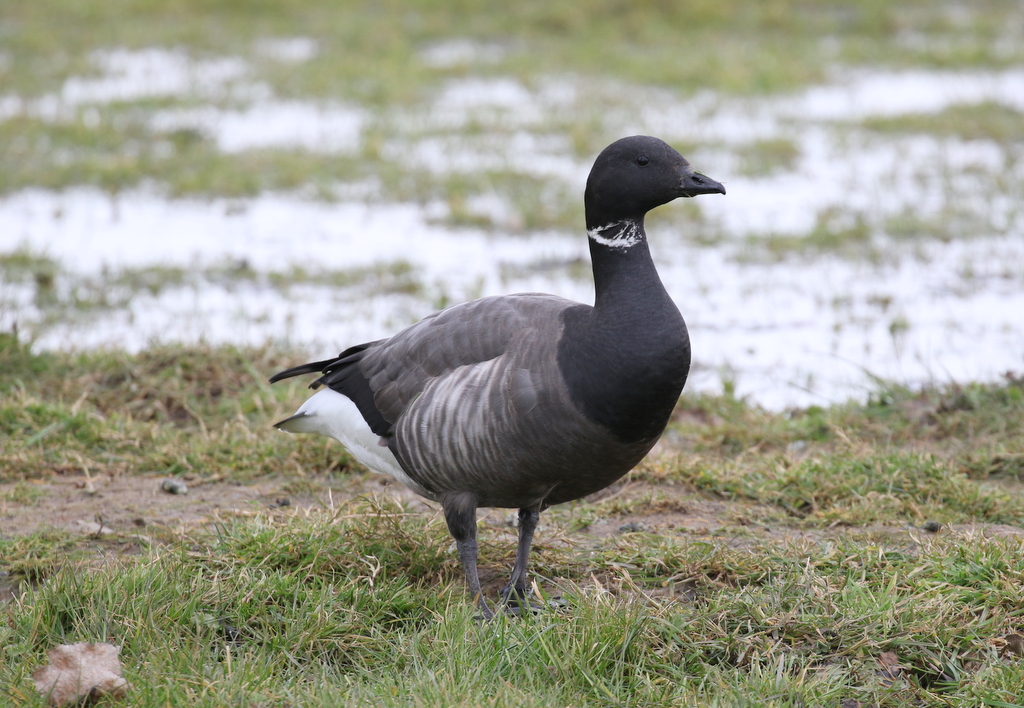
After lunch, we made our way out through the pines and down onto the saltmarsh. As we walked east another five Rock Pipits were feeding in the vegetation on the edge of the path. A party of six Skylarks were incredibly well camouflaged against the browns of the saltmarsh plants.
The Shorelarks were not in their favoured spot today, so we continued on a little further and quickly located them on the edge of the dunes. We walked over for a closer look. They were initially feeding on the high tide line, picking at the line of dead vegetation looking for seeds, but then they ran up into the dunes and started to poke around in the marram grass.
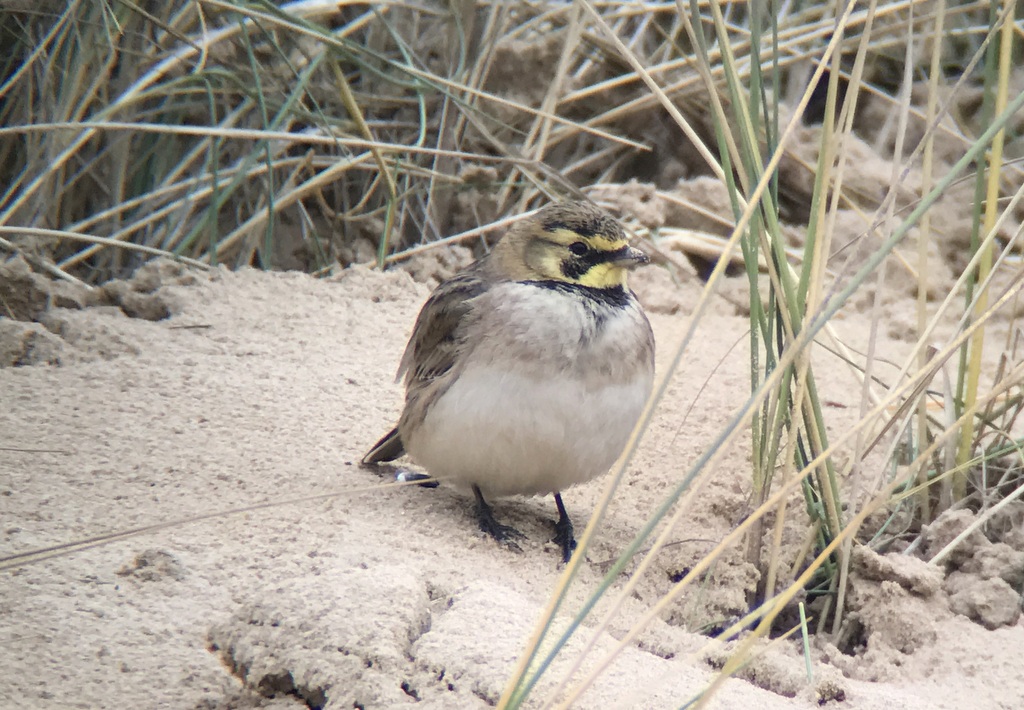
We edged our way a little closer and had great views of the Shorelarks as they emerged from the grass and stood preening on the edge of the dune. We could see their yellow faces and black masks and collars, and we could even make out the small black horns on one or two of them. Then they ran down onto the beach and started to feed along the high tide line again.
Eventually, we had to tear ourselves away from enjoying watching the Shorelarks. As we walked back towards the pines, we had a quick look out towards the sea through the gap in the dunes. A single Great Crested Grebe was diving offshore. Back at the car, a scan of the grazing marshes again revealed a Common Snipe tucked down on the edge of one of the pools.
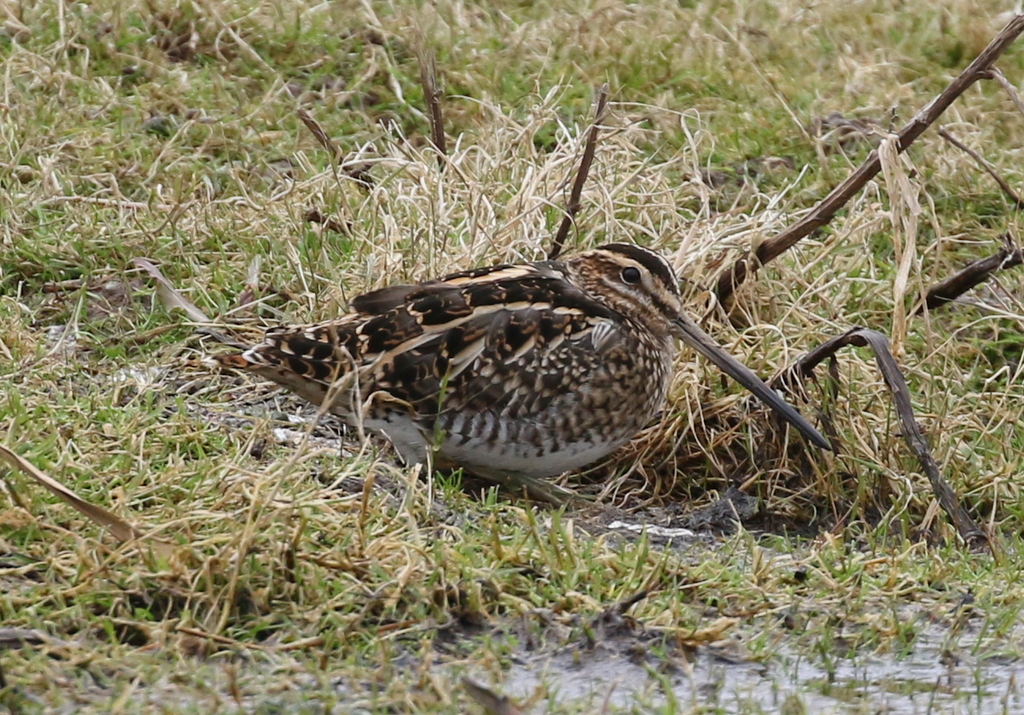
There were several options for the rest of the afternoon, but with a report of one of the Iceland Gulls seen flying past Cromer again, we decided to head back for another look. On our way back east, we noticed a white shape on a gatepost beside the road as we passed, a Barn Owl. After struggling to hunt in the snow, they have been hungry since and have been spending much more time out in daylight hours. We turned round and tried to sneak up on it in the car, but with another car coming past the other way, it flew off over the field as we approached.
When we arrived at Cromer, there were surprisingly few gulls on the beach. With the tide out, we had assumed that lots of birds would come in to feed on all the storm debris again. We spoke to one of the people who had seen the Iceland Gull fly past earlier, but there had been no further sign of it.
We decided to try our luck back along the coast at West Runton instead. The clouds had cleared now and the sun was out, bathing the beach in glorious late afternoon light. There were lots more gulls here, so we set about scanning through them. We hadn’t gone too far, when we spotted a smart adult Mediterranean Gull.

The Mediterranean Gull‘s bright red bill and white wing-tips particularly stood out, relative to all the commoner Black-headed Gulls. It was still mostly in winter plumage, with a black bandit mask behind the eye and peppering of dark in the rear crown.
There were lots of waders around the rock pools down on the beach too. Several Grey Plover, Knot, Redshanks and Dunlin, feeding in between the gulls. Another Purple Sandpiper was harder to see among the rocks. A flock of Sanderling appeared, running around on the sand over towards the water’s edge.
We couldn’t find any sign of the Iceland Gull here, but we did manage to pick out a 2nd winter (3rd calendar year) Caspian Gull among the Herring Gulls. It stood out immediately with its long legs and long neck, standing tall. It also had a distinctive long, pointed face with a long bill, exaggerated by its white head and small dark eye. Unfortunately, we were just admiring it when a dogwalker came around the end of the groyne and flushed all the gulls from that part of the beach.
The school group which had been out on the beach had just left, so a lot of the smaller gulls flew in to feed on the sand just beyond the access ramp. In with all the Black-headed Gulls and Common Gulls, we found another two more Mediterranean Gulls. These had much more black on the head that the one we had seen earlier, meaning there were at least three different individuals here this afternoon.
It was lovely out on the beach in the late sunshine, but the owner of the car park came down to tell us that it was about to be locked up, so it meant we had to walk back up to the top of the cliffs to get the car out. It had been a great day, but it was now time to head for home anyway.
















